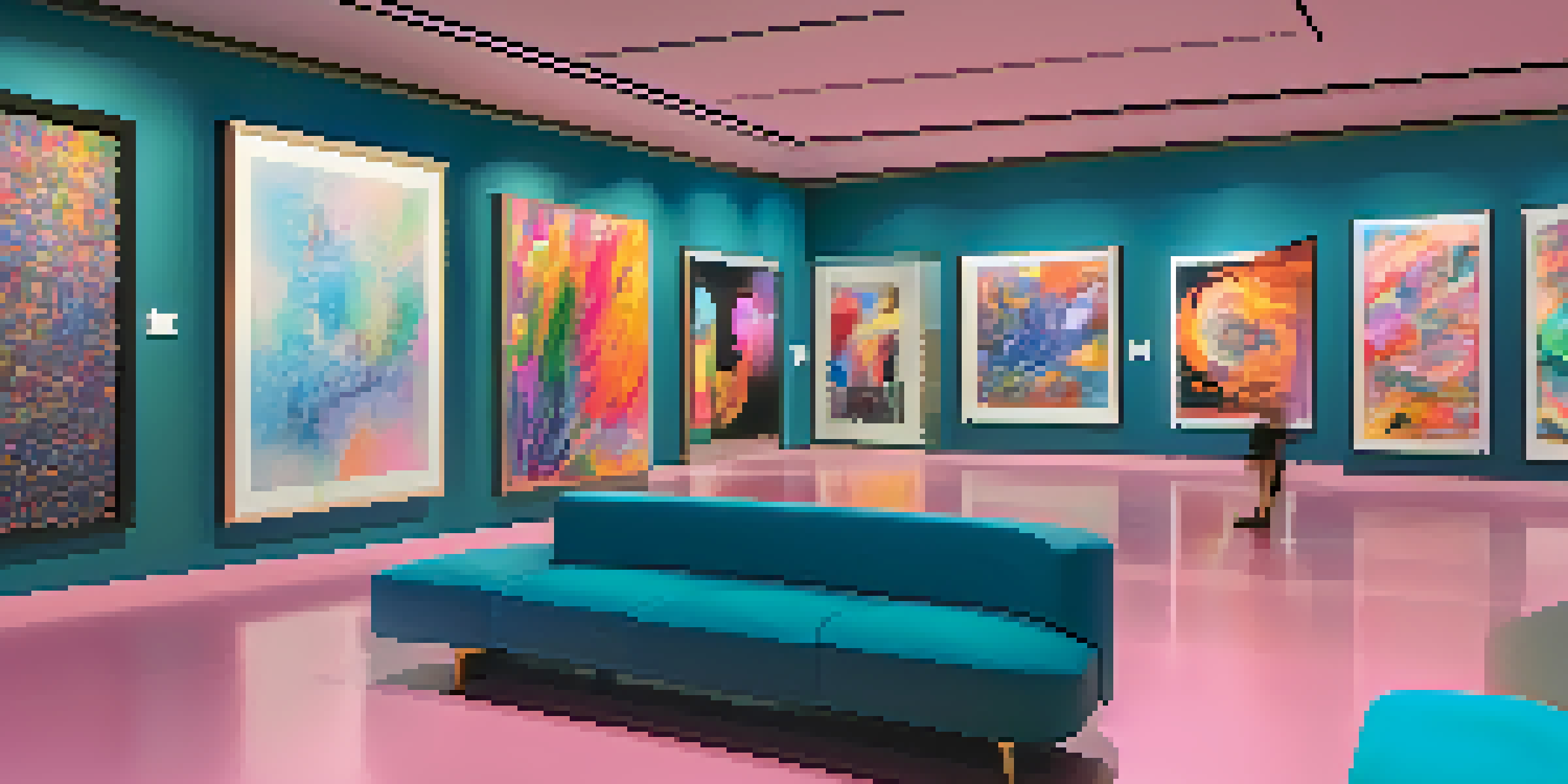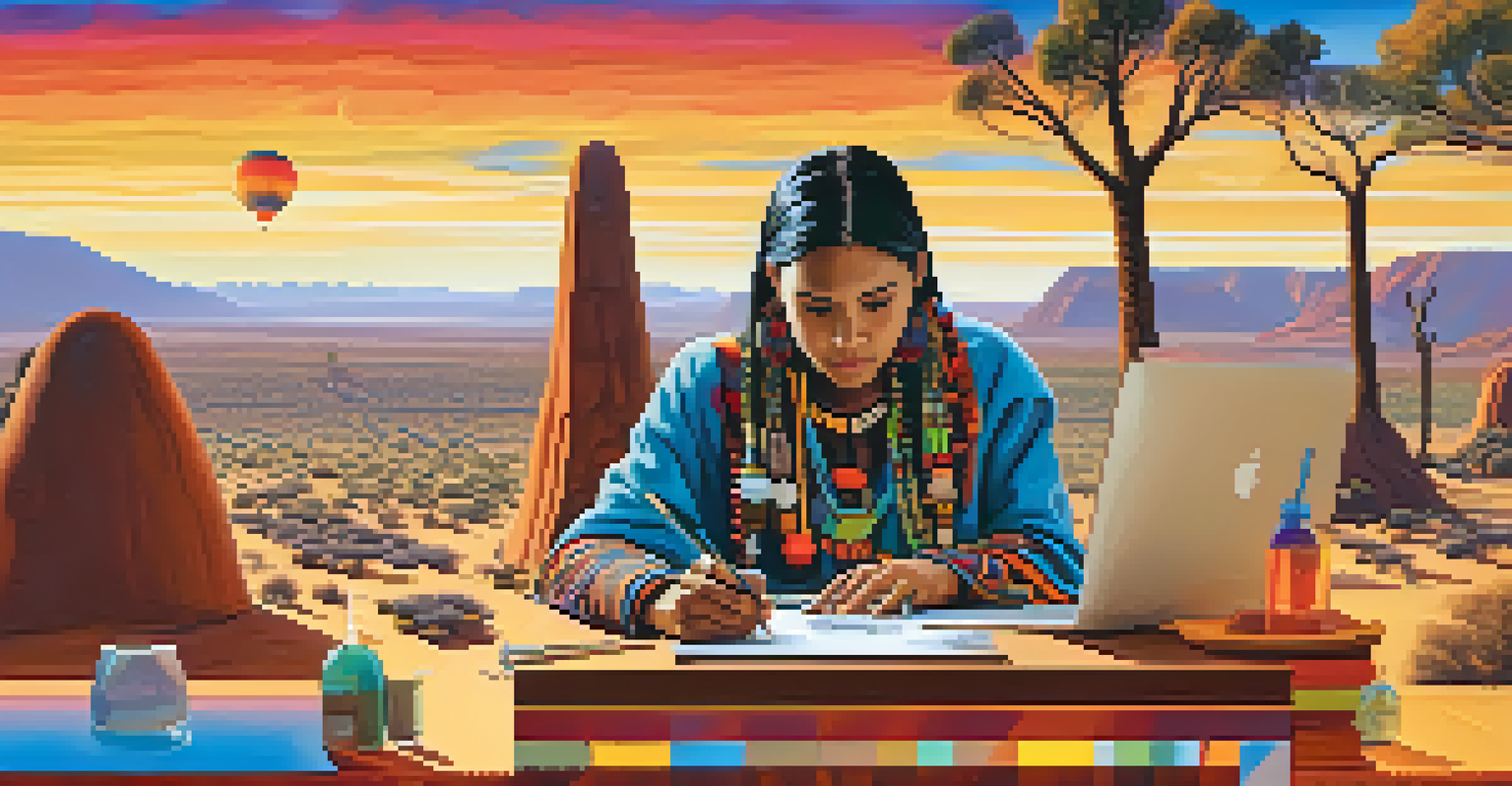NFTs and Digital Art: A New Frontier in Cultural Exchange

Understanding NFTs: The Basics of Digital Ownership
NFTs, or Non-Fungible Tokens, are unique digital assets verified using blockchain technology. This means that each NFT has distinct information that makes it one-of-a-kind, unlike cryptocurrencies like Bitcoin, which are interchangeable. When you buy an NFT, you're not just purchasing a digital file; you're acquiring ownership rights that are recorded on a decentralized ledger.
The future of art is not just bright; it's being redefined right before our eyes.
Imagine owning a rare baseball card. Just like that card, an NFT can represent something unique in the digital world, whether it's artwork, music, or even virtual real estate. This ownership is what sets NFTs apart, creating a sense of value and scarcity that wasn't possible before. As more people recognize the worth of digital assets, NFTs have become an exciting frontier in the art world.
In essence, NFTs allow creators to sell their work directly to collectors, bypassing traditional galleries and auction houses. This shift not only empowers artists but also gives buyers a way to support them directly. As we dive deeper into the world of NFTs, we'll explore how this new technology is transforming the landscape of digital art and cultural exchange.
The Rise of Digital Art: A New Medium for Creativity
Digital art has been around for decades, but it wasn’t until the advent of NFTs that it gained significant recognition and value in the art market. Artists are now able to create stunning works using software and digital tools, pushing the boundaries of creativity. From intricate illustrations to immersive virtual experiences, digital art encompasses a wide range of styles and techniques that resonate with modern audiences.

Consider the case of Beeple, a digital artist who sold a single NFT for a staggering $69 million. This sale not only catapulted digital art into the mainstream but also challenged traditional perceptions of art ownership and value. Suddenly, what was once viewed as mere pixels on a screen became a coveted asset, sparking interest from collectors and investors alike.
NFTs Redefine Digital Ownership
NFTs provide unique ownership rights for digital assets, transforming how art and culture are valued in the digital space.
As more artists explore digital mediums, the variety of art available is expanding, encouraging innovation and experimentation. This new era of creativity allows artists to connect with global audiences, share their narratives, and push cultural boundaries like never before. The rise of digital art is not just a trend; it's a cultural shift that invites everyone to participate in the conversation.
NFTs and Cultural Exchange: Bridging Global Communities
One of the most exciting aspects of NFTs is their ability to facilitate cultural exchange across borders. Artists from different backgrounds can share their work with a global audience, fostering a sense of community and collaboration. This access can lead to new artistic influences, allowing cultures to blend and evolve in unprecedented ways.
NFTs are not just digital assets; they're a new way to express creativity and connect with people across the globe.
For example, an Indigenous artist in Australia can showcase their work to collectors in Europe or North America, while gaining recognition and appreciation for their heritage. This global visibility not only elevates the artist but also educates others about diverse cultures and perspectives. NFTs are breaking down barriers, allowing creativity to flow freely across geographical and cultural divides.
As we witness this cultural exchange unfold, it becomes clear that NFTs are more than just a financial investment—they are a tool for storytelling and connection. By embracing the uniqueness of varied artistic expressions, we can appreciate the rich tapestry of global culture in a way that was never possible before. This aspect of NFTs is what makes them truly revolutionary.
Challenges Facing NFTs: Environmental and Ethical Concerns
Despite their potential, NFTs are not without challenges. One significant concern is the environmental impact of blockchain technology, particularly in terms of energy consumption. The process of minting NFTs can be resource-intensive, leading to questions about sustainability in a world increasingly focused on eco-friendliness.
Additionally, the NFT space grapples with ethical issues, such as copyright infringement and the potential for art theft. Artists have reported instances of their work being sold as NFTs without their consent, highlighting the need for better protections and regulations within the industry. This raises important questions about ownership rights and the responsibilities of platforms that host NFTs.
Challenges of NFTs Persist
Despite their potential, NFTs face significant environmental and ethical concerns that need to be addressed for sustainable growth.
Addressing these challenges is crucial for the long-term viability of NFTs in the art world. By fostering conversations around sustainability and ethics, we can work towards creating a more responsible NFT marketplace. This not only benefits artists but also helps ensure that the cultural exchange facilitated by NFTs is respectful and equitable.
The Future of Art: NFTs as a New Revenue Stream
As the art market evolves, NFTs present a fresh revenue stream for artists, allowing them to monetize their work in innovative ways. Through smart contracts, artists can earn royalties every time their NFT changes hands, ensuring ongoing financial support for their creations. This model fundamentally shifts the traditional art market, where artists often receive little after their initial sale.
Imagine attending an exhibition where you can purchase digital art directly from the artist, who continues to benefit from future sales. This direct-to-collector approach not only empowers artists but also fosters a deeper connection between creators and their audience. It's a win-win situation that encourages both investment in art and support for the artists behind it.
As we look ahead, the potential for NFTs to reshape the art landscape is immense. With more artists embracing this technology, we can expect to see a proliferation of unique digital works that challenge our understanding of art and ownership. The future of art is not just bright; it's being redefined right before our eyes.
Collecting NFTs: What Every New Collector Should Know
If you're considering diving into the world of NFT collecting, there are a few key points to keep in mind. First, research is essential. Familiarize yourself with various platforms, types of NFTs, and artists to understand the market landscape. Whether you’re drawn to digital paintings, music, or virtual real estate, knowing your options will help you make informed decisions.
It's also important to consider the value of the community behind the NFT. Engaging with artists and fellow collectors can enrich your experience and provide insights into emerging trends. The NFT space thrives on collaboration and shared passion, making connections vital to your collecting journey.
NFTs Create New Revenue Streams
NFTs allow artists to earn ongoing royalties through smart contracts, reshaping the traditional art market.
Finally, always ensure you're using secure wallets and platforms for your transactions. As with any investment, being cautious and informed is key to a successful collection. By approaching NFT collecting with curiosity and care, you can become a part of this vibrant new art movement while supporting creators in the process.
Conclusion: Embracing the Future of Digital Art and Culture
In conclusion, NFTs are ushering in a new era for digital art and cultural exchange. They offer artists unprecedented opportunities to share their work and connect with audiences around the globe. As we continue to explore this innovative technology, we must also address the challenges it presents, ensuring a sustainable and ethical marketplace.
The journey of NFTs is just beginning, and the potential for creativity and collaboration is limitless. By embracing this new frontier, we can support artists and celebrate diverse cultural expressions in ways we never thought possible. The future of art is not only digital but also deeply interconnected.

As we reflect on the possibilities ahead, let us remain open to the dialogues and discoveries that NFTs will bring. By participating in this evolving landscape, we have the chance to shape the future of art and culture, making it a richer, more inclusive experience for everyone.